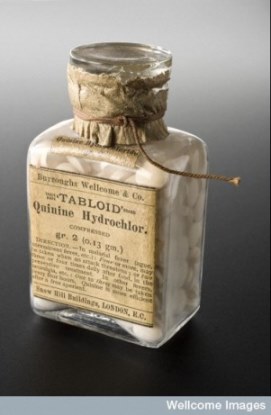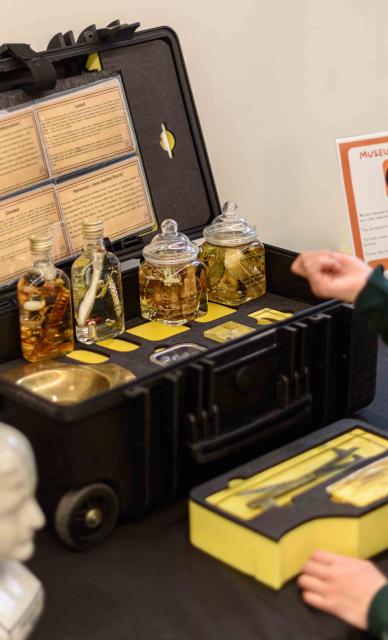Support us
As a charity we rely on your donations to fund our free exhibitions, school activities and online resources
Empowering medical excellence, shaping healthcare futures.
George Cleghorn (1716-1789), medical pioneer and gifted surgeon-anatomist, was born in Granton, just outside Edinburgh, on the 18 December 1716. Cleghorn was the son of a farmer and the youngest of five children. He was educated at the local grammar school in Cramond, before being sent to Edinburgh in 1728 to gain further knowledge of Latin, Greek, French and mathematics. He entered the University of Edinburgh in 1731 as a student of physic and surgery. Cleghorn studied under and lodged with Dr Alexander Monro for five years. During his time in Edinburgh Cleghorn was introduced to John Fothergill and the two became lifelong friends and correspondents. Together with Fothergill, Russell, Cuming and Hamilton, he founded a society, which would later become the Royal Medical Society of Edinburgh.

At the recommendation of Dr. St. Clair, Cleghorn was appointed surgeon to the 22nd regiment of foot, who were stationed on the island of Minorca. He remained in Minorca for 13 years, during which time he corresponded with Fothergill in Latin on the medical observations he made about the island. Cleghorn’s regiment was sent to Dublin in 1749 and on his return from the Mediterranean he was persuaded by Fothergill to publish his observations. While overseeing the publication of this work in London in 1750, Cleghorn attended the anatomical lectures of Dr. William Hunter in the Great Windmill Street School. Cleghorn’s work, Observations on the Epidemical Diseases in Minorca from the Year 1744 to 1749, was published in 1751. It went through a total of five editions and was published in German in 1776. Cleghorn also made valuable contributions to the Medical Observations and Inquiries.

Cleghorn’s treatise was one of the earliest works on epidemiology and it became a classic in its field. It contained many original observations and included several accounts of post-mortem examinations performed by the author. Cleghorn is credited with demonstrating that quinine bark was effective as a remedy against malaria. He was also the first person to describe infectious hepatitis and the first scientist to write observations on meteorology in the Iberian region.
Back in Dublin Cleghorn established a successful surgical practice and began to give private lectures in anatomy. In 1761 he succeeded Robinson as lecturer in anatomy at Trinity College Dublin, becoming the first surgeon to hold the post. Under the School of Physic Act of 1785 the Lectureship was elevated to the status of a Professorship, making Cleghorn the first anatomy professor at Trinity College Dublin. Cleghorn appears to have been an inspirational teacher and his lectures were popular. He chose to teach in English instead of the traditional Latin and in one year his course attracted as many as 95 students. Cleghorn set out his teaching in a pamphlet, Index of an annual course of lectures (Dublin, 1767). From this we can tell that he taught comparative and surgical anatomy and the principles of physiology, as well as basic human anatomy. Cleghorn is recognized as laying the foundations of a celebrated anatomical school in Ireland and was awarded an honorary MD by Trinity College in 1768. In 1784 he was elected an honorary fellow of the King and Queen’s College of Physicians in Ireland. In 1777 he was made a fellow of the Royal Medical Society in Paris. In addition, he is listed as a member of the Medical Society of London in 1789 and as a corresponding member of the Society of Antiquaries of Scotland in 1781.
He became a member of the Dublin Medico-Philosophical Society on the 15 September 1757. The Society was a small, self-funded, and self-selecting improvement society, which met on a bi-monthly basis at the homes of its members, to present and discuss medical and scientific papers on new and improving subjects. It was a band of virtuosi, a talented and influential group of, mainly, though not exclusively, physicians, surgeons and apothecaries. Its membership included John Rutty (1698-1775), David MacBride (1726-78), Charles Smith (c.1715-1762) and several other distinguished medics. Cleghorn delivered many papers to the Society and participated in extensive correspondence with leading medics from Ireland, England, Scotland and further afield. This correspondence was read before the members. Letters read to the Society came from individuals such as the famous physician, anatomist, and man-midwife, William Hunter (1718-1783), Sir John Pringle (1707-1782), the military physician and epidemiologist, and Robert Whytt (1714-1766), the physician and natural philosopher. Cleghorn’s other correspondents included the physician, chemist and agriculturalist William Cullen (1710-1790), the physician and botanist John Fothergill (1712-1780), and the physician and philanthropist, John Coakley Lettsom (1744-1815). Cleghorn was made an honorary member of the Society in 1772. He was also a member of the Dublin Society from 1762-1787 and became, like several other members of the Medico-Philosophical Society, a founding member of the Royal Irish Academy in 1785.
His successful medical practice and professorship enabled him to buy substantial lands in Co. Meath. Cleghorn had no children of his own but cared for his deceased brother’s widow and their nine children. One of these children, William Cleghorn, graduated M.D. from Edinburgh in 1779, with a thesis on the theory of fire. William was a gifted student and in his dissertation he produced a systematic description of caloric which would remain in use for the next seventy years. It was Cleghorn’s hope that William would succeed him in the professorship. Sadly, William died before he could replace his uncle and the position was instead taken by James Cleghorn, another nephew, in 1790. However, unfortunately James demonstrated no significant interest in or aptitude for anatomy. Cleghorn died on 22 December 1789, of asthma and dropsy, at his country home in Kilcarty.
Selected Bibliography
Coakley, Davis, Medicine in Trinity College Dublin: An Illustrated History, (Dublin: Trinity College Dublin, 2014)
Coakley, Davis, Irish Masters of Medicine, (Dublin: Town House, 1992)
Lettsom, John Coakley, Memoirs of John Fothergill, M.D. &c., 4th edn., (London, Printed for C. Dilly, 1786)
Lienhard, John H., How Invention Begins: Echoes of Old Voices in the Rise of New Machines, (Oxford; New York: Oxford University Press, 2006)
Lunney, Linde, ‘Cleghorn, George’, in Dictionary of Irish Biography, (ed.) James McGuire, James Quinn, (Cambridge: Cambridge University Press, 2009)
Moore, Norman, ‘Cleghorn, George (1716-1789)’, rev. Claire E. J. Herrick, in Oxford Dictionary of National Biography, (Oxford: Oxford University Press, 2004)
Scally, Rachael, ‘Enlightenment and the Republic of Letters at the Dublin Medico-Philosophical Society, 1756-1784’ in University of Dublin, Trinity College, Journal of Postgraduate Research, 14, (2015), pp.156-178
Author: Rachael Scally, D.Phil. candidate in History at Christ Church College, Oxford

Support us
As a charity we rely on your donations to fund our free exhibitions, school activities and online resources